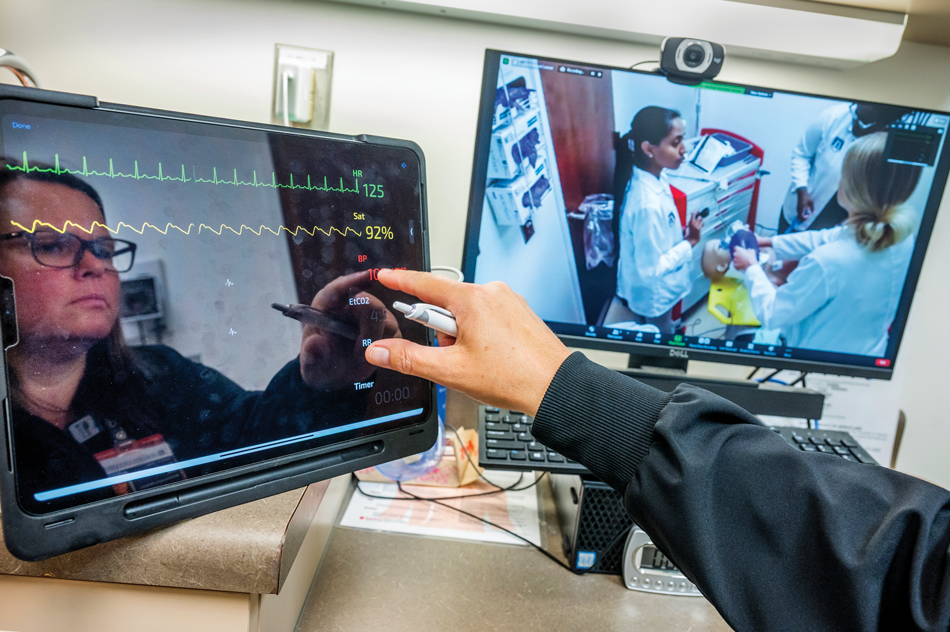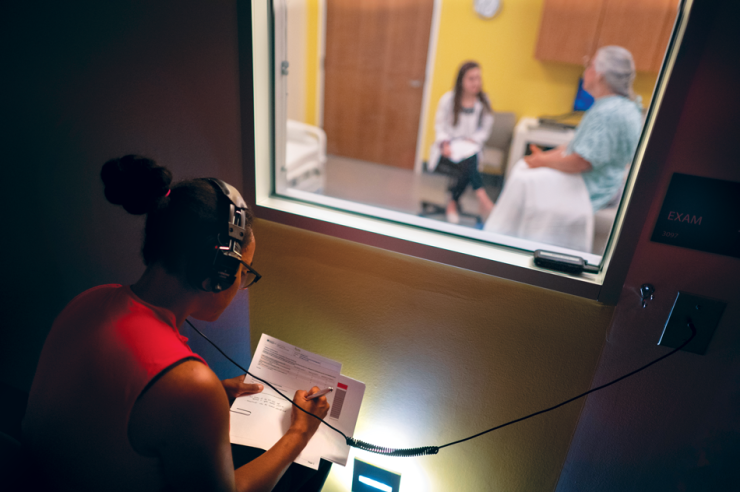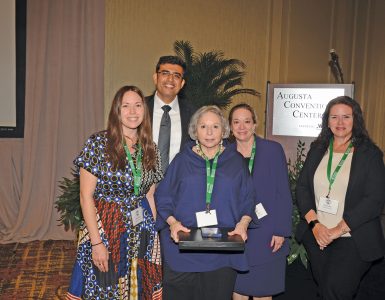They’re the only places you’d be ok with a future physician failing.
In simulated scenarios where high-fidelity mannequins mimic clinical environs, from a car crash victim rolling into the emergency room with shortness of breath caused by an undetected tension pneumothorax, to an ICU patient whose blood pressure is suddenly bottoming out.
Using portable ultrasound machines on each other and at a pretend patient’s bedside, scanning their chest and torso for a potentially life-threatening abdominal aortic aneurysm.
Learning to take a comprehensive health history, and potentially expose barriers to care for a patient hundreds of miles away in a rural or underserved area of the state.
Training to safely place central lines, large IVs frequently given to draw blood and deliver nutrients to patients, on a cadaver instead of a real patient.
It’s all part of an evolving curriculum at the state’s only public medical school called Experiential Learning, that, as its name implies, is aimed at maximizing medical education and ultimately improving patient outcomes through structured, realistic experiences.
The concept, which starts for students in the first days of medical school, is divided into four areas — educational simulation, ultrasound education, telemedicine education and procedural skills training.
“Students are getting the book learning, but they’re also getting to do these things to practice what they’re learning,” explains Dr. Matt Lyon, a 1999 MCG graduate and emergency medicine physician, who is associate dean for Experiential Learning at his alma mater. “Experiential learning is an action verb. When I went to medical school, people told you how to do things, but you didn’t get to do them until you got to clerkship (clinical settings). This is truly learning by doing. That’s how you learn in residency. We’re just starting earlier.”
The hope, he says, is that MCG faculty can identify and address students’ knowledge gaps earlier, often, and effectively.
“The value of Experiential Learning is that we provide learners with the opportunity to apply the knowledge they’re learning in the classroom,” adds Dr. AJ Kleinheksel, MCG’s assistant dean for educational simulation. “They’ll obviously do these things bedside, but this gives them the opportunity for earlier exposure that is safe, both for patients, but also safe for them psychologically. Because they have the freedom to fail in a constructive environment. I tell them all the time that the only failure is if you don’t learn from the experience.”
The sum of the parts
The parts that make up the whole are not new to MCG.
Students have been learning to use point of care ultrasound to better visualize the anatomy (MCG Medicine Spring/Summer 2018) since around 2014. MCG’s Educational Simulation program, which recently became the first in Georgia to receive accreditation by the Society for Simulation in Healthcare, was established in 2017. Students have used standardized patients, essentially actors who pretend to have a certain medical condition that students have to figure out, for longer than that.
MCG residents and fellows started procedural skills training using ultrasound to better place central lines in cadavers — a program that reduced central line complications at AU Health System, MCG’s primary teaching affiliate, to nearly zero — as early as 2016.
Telemedicine became pervasive in the health care world during the COVID-19 pandemic. It’s use at MCG and AU Health can be traced back decades to when neurologist and now-MCG Dean Dr. David Hess and other MCG faculty pieced together an early version of the REACH telestroke network, which enabled timely stroke diagnosis by eliminating the distance between patients and stroke specialists. In more recent years, and even before COVID, MCG emergency medicine physicians, like Lyon, also helped develop a network of hospitals and helped manage patient care through telemedicine technology, eliminating unnecessary transfers and increasing revenue for struggling rural hospitals.
But Experiential Learning, Lyon says, is the sum of the parts — it’s about weaving all of those skills and structured clinical encounters through every stage of medical education. And it’s something MCG adopted early.
There is a trend toward more experiential learning in medical education, but it’s a slow adoption curve and there is wide variability in quality, Kleinheksel explains. “I think what we offer that is unique (in medical education) is both consistent best practices across multiple modalities of experiential learning, and real curricular integration. It’s hard to argue against the value of early standardized exposure, repeated practice, patient safety and learner safety. But many medical faculty just don’t have the expertise or resources to establish and run high-functioning programs like those in Experiential Learning here. The investment MCG has made into infrastructure and expertise is what’s putting us ahead of the curve.”
Lyon says it’s also an investment that will be essential to the success of the medical school’s shortened 3+ curriculum, which pares down classroom and clinical training from 48 to 36 months. MCG opted for a shortened curriculum in order to reduce student costs, make medical education more attractive and affordable and produce more physicians for Georgia, all while still maintaining quality in education and producing the well-prepared residents its long been known for.
One way to do that is by introducing patient experiences earlier than ever before, Lyon says. “These things were layered on top of the legacy curriculum, with a kind of get it in where it fits in approach. Now they are the curriculum,” he says.
From day one
Experiential Learning began day one for the MCG Class of 2024, the first class to be fully immersed in the new 3+ curriculum — with their education divided into 18 months of preclinical work and 18 months of clerkships.
That will continue for every subsequent class.
Students spend several hours weekly in small rooms in the Center for Ultrasound Education where they learn to use small, portable ultrasound machines to visualize the anatomy they’re learning in the classroom and gross anatomy lab in a living, breathing person.
It’s there that they also learn telemedicine and how to talk to patients — both real and standardized — who are many miles away through the Wi-Fi connection on a computer and learn basic skills, like how to take a complete health history.
They can also encounter clinical scenarios there, like that car crash victim — a mannequin mimicking labored respirations — and learn under the watchful eye of MCG faculty, who observe from another room, how to identify that tension pneumothorax and then learn just where to place a needle, to relieve the pressure and help the patient breathe normally again.
In their patient-centered-learning course, students work weekly with high-fidelity mannequins and standardized patients in the Augusta University Interdisciplinary Simulation Center that can mimic a variety of clinical scenarios that help acquaint them with the basics of the clinical environment. When they reach their clerkship years, they run through scenarios focused on specialties, testing their skills on cases that could present, for example in family medicine, like using ultrasound to detect an abdominal aortic aneurysm, or in OB/GYN, like a patient with a postpartum hemorrhage.
“We want to encourage them to think like a doctor, to act like a doctor,” Lyon says.
“The learning outcomes are significant,” Kleinheksel adds. “(All of this) can affect everything from patient outcomes to professional identity formation. Transitioning to residency is jarring for a lot of people and if you’re focused on that feeling of disorientation, it’s hard to focus on the medicine. We are trying to promote feelings of professional identity earlier in medical education. That way when they get to their first day of (their residency), they’re not overwhelmed. They have a sense of what it’s like to own patient care, because they have owned patient care here.”

“They’ll obviously do these things bedside, but this gives them the opportunity for earlier exposure that is safe, both for patients, but also safe for them psychologically. Because they have the freedom to fail in a constructive environment. I tell them all the time that the only failure is if you don learn from the experience.” – Dr. A.J. Kleinheksel
And beyond
While Experiential Learning is woven throughout the undergraduate medical school experience, it doesn’t stop there. Lyon calls it a “learning continuum” that has implications not just for medical students, but for residents, fellows, faculty and community physicians. “We start on day one (of medical school), but this whole concept is really about ensuring lifelong learning,” he says.
For example, even before their first day on the job, new residents and fellows at MCG spend a day in the Interdisciplinary Simulation Center, which looks, feels, even smells like a hospital, and they work on sighting potential patient safety hazards in a simulated environment – like an uncapped needle in a patient’s bed or water that’s splashed from the sink onto the floor creating a potential fall risk.
Shortly after they start their training, those same residents and fellows go to the university’s gross anatomy lab and are tested on how to use ultrasound to more safely place central lines in the veins of cadavers, in an effort to reduce the associated blood infections that result in thousands of deaths each year and thousands of dollars in costs added to health care systems. If they don’t pass, they have to remediate until they do.
Physicians from across the country attend continuing medical education courses at the Center for Ultrasound Education, testing their clinical skills and learning from MCG faculty how to use point of care ultrasound as a diagnostic tool. Training courses open to community physicians looking to maintain their clinical skills are held regularly at the simulation center.
It also doesn’t stop in Augusta.
A grant from the US Health Resources and Services Administration allowed Georgia’s Area Health Education Centers, which exist to improve the supply, distribution, retention and quality health practitioners in medically underserved areas, to purchase simulation kits for every MCG regional campus. While they aren’t full-size high-fidelity mannequins, like those in the simulation center in Augusta, these kits — which may contain a mechanized arm where students can take a pulse or blood pressure or start an IV for instance — enable the replication of educational simulation in every corner of the state. That means every student who is in their clerkship years has access to the same simulated scenarios for every single clerkship, no matter where they are learning.
 “Simulation had previously been an area where there hasn’t been a lot of parity for students who are on regional campuses,” Kleinheksel says. “Those students would have to come back to Augusta or phone in to a simulation. When we’re talking about skill development, you’re going to want to have the hands-on experience.”
“Simulation had previously been an area where there hasn’t been a lot of parity for students who are on regional campuses,” Kleinheksel says. “Those students would have to come back to Augusta or phone in to a simulation. When we’re talking about skill development, you’re going to want to have the hands-on experience.”
The statewide impact also isn’t limited to simulation.
Through grants from the US Department of Agriculture and Federal Communications Commission, MCG has been able to provide every student on every regional campus with a portable ultrasound machine that is assigned to them that they can use in clinical rotations. That has the added benefit of not just allowing students to continue their ultrasound education wherever they are learning in Georgia, but also giving volunteer faculty who are teaching MCG students access to that technology and, in turn, offering courses to educate them, Lyon says.
“This is ultimately about increasing MCG’s reach and impact across the state,” he says. “As a student, you can have the same experience wherever you are, due to the technology and expertise we have here.”
Measuring the impact
How will we know any of this works?
It’s a question Lyon always anticipates and quickly answers — we measure it.
In 2014, the Association of American Medical Colleges coined the term “entrustable professional activities,” or EPAs — a list of 13 things that all graduates transitioning from medical school to residency are expected to know how to do. They cover the gamut, from gathering a history and performing a physical exam to collaborating as a member of an interprofessional team, from identifying systems failures to obtaining consent for tests and procedures.
At MCG, Kleinheksel, who is also a researcher in the medical school’s Educational Innovation Institute, has developed an instrument that measures these EPAs across pre-clerkship and clerkship years to see how a student is progressing. Not every student is going to reach a point where they don’t need any help on any of those 13 measures, they say. But the key is identifying progress and identifying areas that need improvement, before students graduate.
“These EPAs translate into what residents call milestones. It’s the same concepts, just different language,” Lyon says. “For the students who enter Georgia residency programs, we will also be able to measure their progress using the same assessments. This all ultimately helps us educate better physicians for the state and country and improve care for patients.”









